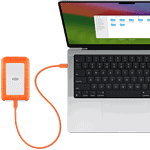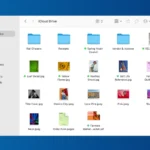Center Stage is a feature designed by Apple to keep users in focus during video calls. It uses the ultra-wide camera on compatible devices and machine learning to adjust the frame as the user moves. This technology ensures that even when moving around the room, the user remains in the center of the view, allowing for a more dynamic and engaging conversation.
Mac users with Studio Display can take advantage of Center Stage during FaceTime calls or with other compatible apps. Activating or deactivating the feature involves a simple toggle within the Control Center. This addition to the Mac ecosystem extends the user experience from the iPad, bringing a seamless and intuitive feel to video calling on a larger screen.

Center Stage Feature on Mac
Center Stage is Apple’s smart camera feature that automatically keeps you in the frame during video calls. It uses machine learning and the ultra‑wide camera on supported devices to pan, zoom, and follow you as you move around.
🖥️ 1. What is Center Stage?
- First introduced on iPad, later brought to Macs with Apple Studio Display and Continuity Camera (using iPhone as a webcam).
- Uses the ultra-wide camera and software cropping to track your movement.
- Works in FaceTime, Zoom, Teams, Google Meet, and other video apps.
(Source: Apple Support)
💻 2. How to Enable Center Stage on Mac
If You’re Using Studio Display:
- Connect your Studio Display to your Mac.
- Open Control Center (menu bar, top right).
- Click Video Effects.
- Select Center Stage.
If You’re Using iPhone as a Webcam (Continuity Camera):
- Mount your iPhone near your Mac.
- In a video app (FaceTime, Zoom, etc.), select your iPhone as the camera.
- Open Control Center → Video Effects → Center Stage.
👉 Once enabled, the camera will automatically follow you.
🎛️ 3. Adjusting Center Stage
- To turn off Center Stage, go back to Control Center → Video Effects → Center Stage and toggle it off.
- Some apps (like Zoom) also let you toggle Center Stage in their video settings.
- You can also manually pan and zoom when Center Stage is off (source: Apple Support).
📦 4. Requirements for Center Stage on Mac
- macOS Monterey or later.
- A Mac connected to:
- Apple Studio Display OR
- An iPhone (iPhone XR or newer) via Continuity Camera.
- Not available on built-in MacBook or iMac cameras (they don’t have ultra-wide lenses).
(Source: AppleInsider)
✅ 5. Best Uses for Center Stage
- Video calls: Stay centered even if you move around.
- Presentations: Walk around while explaining, without leaving the frame.
- Group calls: Camera zooms out to fit multiple people in view.
⚠️ 6. Limitations
- Requires supported hardware (Studio Display or iPhone).
- Slight cropping reduces video resolution.
- Works best in well-lit environments.
📝 Bottom Line
The Center Stage feature on Mac makes video calls more natural by automatically keeping you in frame. It’s easy to enable via Control Center → Video Effects, but it requires either a Studio Display or an iPhone as a webcam.
Key Takeaways
- Apple’s Center Stage keeps users in focus during video calls.
- Compatible with certain iPad and Mac models, enhancing cross-device functionality.
- Activating it requires toggling settings in the Control Center.
Center Stage on iPad and Mac
Apple’s Center Stage technology enhances video calls by keeping users in focus. It employs the ultra wide camera on specific iPad and Mac models and uses machine learning to adjust the frame as users move.
Evolution and Compatibility
Apple first introduced Center Stage on iPad models and has since extended it to certain Mac devices. It works with the following:
- iPad Pro 12.9-inch (5th generation or later)
- iPad Pro 11-inch (3rd generation or later)
- iPad Air (5th generation)
- iPad (9th generation or later)
- iPad mini (6th generation)
- Studio Display
- Mac Studio
The feature also requires macOS or iPadOS with the latest updates.
Center Stage Functionality
Center Stage uses the ultra wide camera to track movement during video calls. Users turn it on or off in Control Center by swiping or clicking the Video Effects button. Once active, the camera keeps them in the frame as they move. This feature works with FaceTime and third-party apps like Zoom, Skype, and Google Meet. Users can also manage Center Stage directly from the video thumbnail during calls.
Enhancing User Experience with Center Stage
Center Stage technology provides a more dynamic and engaging experience for Mac users. It keeps them in frame during video calls and integrates seamlessly with various applications, ensuring professionals have top-notch tools at their disposal.
Integration with Professional Applications
Professionals rely on applications for photography and web development. Center Stage is compatible with a variety of video apps like FaceTime, WebEx, Slack, and Twitter. This compatibility offers users a hands-free experience, keeping them centered without manual adjustments. It’s an asset for online meetings and creative work, allowing users to stay focused on the task at hand.
Technical Capabilities and Design
The 27-inch 5K Retina display with 14.7 million pixels and P3 wide color gamut ensures crisp, vibrant visuals. The display, featuring options like nano-texture glass, True Tone, and reference modes, adjusts to the environment’s color and brightness for optimal viewing. It connects via Thunderbolt port and has a VESA mount adapter option, considering varied workspace setups. Cupertino’s innovation with the A13 Bionic chip boosts the performance, supporting the intelligent camera functions of Center Stage.
Visual and Audio Enhancements
Center Stage uses a 12MP ultra-wide camera and machine learning to follow the user’s movements. The audio system includes a six-speaker sound system with high-performance tweeters and Dolby Atmos. This setup along with spatial audio and a three-mic array creates an immersive audio environment. Users can access video effects from the menu bar to adjust settings like color temperature for a personalized effect, enhancing both the visual and audio elements of their calls and captures.







